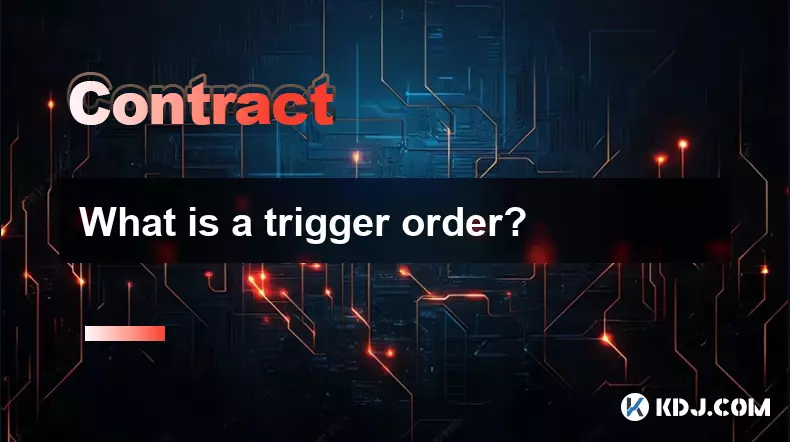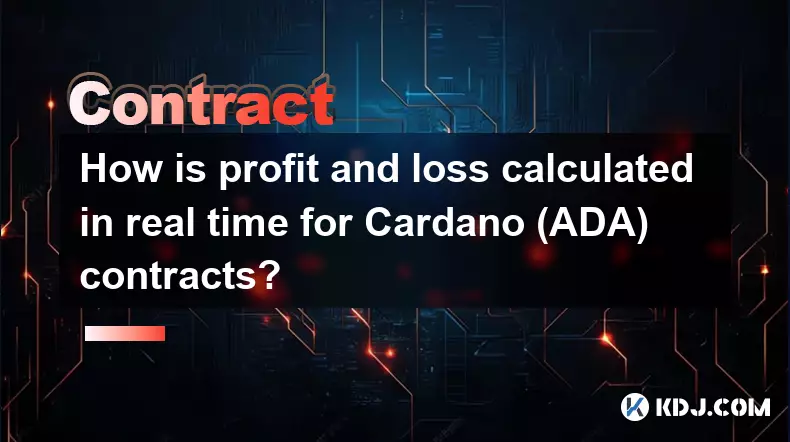-
 bitcoin
bitcoin $109667.069529 USD
-3.03% -
 ethereum
ethereum $3936.685804 USD
-4.07% -
 tether
tether $1.000493 USD
0.01% -
 xrp
xrp $2.771823 USD
-4.74% -
 bnb
bnb $957.805027 USD
-5.34% -
 solana
solana $196.735100 USD
-6.68% -
 usd-coin
usd-coin $0.999727 USD
-0.01% -
 dogecoin
dogecoin $0.227355 USD
-5.12% -
 tron
tron $0.335205 USD
-0.81% -
 cardano
cardano $0.779256 USD
-3.59% -
 ethena-usde
ethena-usde $0.999900 USD
-0.06% -
 hyperliquid
hyperliquid $42.492095 USD
-6.61% -
 chainlink
chainlink $20.501853 USD
-4.34% -
 avalanche
avalanche $28.952606 USD
-11.21% -
 stellar
stellar $0.356038 USD
-3.93%
What is a trigger order?
Trigger orders automate crypto trades when preset conditions are met, helping manage risk and capitalize on volatility without constant market monitoring.
Sep 23, 2025 at 04:55 pm

Understanding Trigger Orders in the Cryptocurrency Market
A trigger order is a conditional trading instruction that activates a specific trade when predefined market conditions are met. These orders allow traders to automate their strategies without constant monitoring of price movements. By setting a trigger price, users can execute buy or sell actions automatically once the asset reaches that level. This mechanism is particularly useful in the highly volatile cryptocurrency markets, where prices can shift dramatically within minutes.
Types of Trigger Orders
1. Stop-loss trigger orders activate a market or limit order when the price falls to a specified level. Traders use this type to minimize losses during sudden downturns.
- Take-profit trigger orders are designed to lock in profits by selling an asset when it hits a desired price point.
- Buy-stop orders initiate a purchase when the price rises above a set threshold, often used to capitalize on breakout momentum.
- Trailing stop triggers adjust dynamically with the market price, maintaining a fixed distance below (for long positions) or above (for short positions) the highest or lowest observed value.
- Conditional limit triggers combine a trigger condition with a limit order, ensuring execution only at a preferred price or better after the trigger is activated.
Advantages of Using Trigger Orders
Automated execution reduces emotional decision-making, allowing traders to stick to their strategy even during periods of high volatility.- Time efficiency: Traders don’t need to monitor charts continuously, freeing them to focus on analysis or other investments.
- Risk management: Stop-loss triggers help protect capital by exiting positions before losses grow uncontrollably.
- Precision in entry and exit: Take-profit and limit-based triggers ensure trades occur at targeted levels, improving overall trade accuracy.
- Scalability: Advanced traders can deploy multiple trigger orders across various assets simultaneously, managing complex portfolios with ease.
- Accessibility: Most major exchanges support trigger orders, making them available to both novice and experienced participants.
Common Pitfalls and Considerations
Slippage can occur when the market moves rapidly past the trigger price, resulting in execution at a less favorable rate than expected.- False triggers due to temporary price spikes or flash crashes may lead to unintended executions.
- Over-reliance on automation might cause traders to neglect broader market context or macroeconomic signals.
- Not all exchanges implement trigger orders uniformly—some may lack advanced options like trailing stops.
- Network latency or exchange downtime can delay activation, especially during peak volatility.
- Poorly placed triggers based on insufficient analysis can result in repeated losses or missed opportunities.
Frequently Asked Questions
How do I set up a trigger order on a crypto exchange?Navigate to the trading interface, select the asset, choose the order type (e.g., stop-limit), input the trigger price and the execution price, then confirm the order size and submit.
Can trigger orders be canceled or modified after placement?Yes, most platforms allow users to edit or cancel pending trigger orders as long as the condition has not been met and the order hasn't activated.
Do trigger orders guarantee execution at the specified price?No, especially in fast-moving markets. A trigger activates the order, but actual execution depends on liquidity and market depth at that moment.
Are trigger orders suitable for day trading cryptocurrencies?Absolutely. Day traders frequently use them to enter breakouts, secure profits, or limit downside risk without needing to watch the screen constantly.
Disclaimer:info@kdj.com
The information provided is not trading advice. kdj.com does not assume any responsibility for any investments made based on the information provided in this article. Cryptocurrencies are highly volatile and it is highly recommended that you invest with caution after thorough research!
If you believe that the content used on this website infringes your copyright, please contact us immediately (info@kdj.com) and we will delete it promptly.
- Shiba Inu: Token Burns, Shibarium, and the Million-Dollar Meme Dream
- 2025-09-26 21:05:16
- Pepe Dollar, BlockDAG, and Miner Sales: A New Yorker's Take on Crypto's Latest Drama
- 2025-09-26 20:45:16
- BlockDAG: The Smart Crypto Investment in a Meme-Driven Market
- 2025-09-26 21:25:13
- Cryptoization, Emerging Markets, and Financial Resilience: A New Yorker's Take
- 2025-09-26 21:05:16
- BlockchainFX, Crypto Presale, and Lightchain Snorter: What's the Buzz?
- 2025-09-26 20:45:16
- Bitcoin Crash Watch: Glassnode Signals Potential Cooling Phase
- 2025-09-26 20:25:12
Related knowledge

How do I enable the "scalping-only" mode for Cardano (ADA) contracts?
Sep 24,2025 at 03:19am
Understanding Scalping Strategies in Crypto Derivatives1. Scalping in cryptocurrency trading refers to executing multiple short-term trades within min...

What is the maximum position limit for Cardano (ADA) contracts?
Sep 23,2025 at 11:00pm
Understanding ADA Futures and Derivatives Market Structure1. Cardano (ADA) futures contracts are offered by several major cryptocurrency derivatives e...

What is the maker fee for Cardano (ADA) contracts?
Sep 26,2025 at 09:01am
Understanding Maker Fees in Cardano (ADA) Contracts1. The concept of maker fees applies broadly across decentralized exchanges and smart contract plat...

How can I view open interest in Cardano (ADA) contracts?
Sep 24,2025 at 07:36am
Understanding Open Interest in Cardano Derivatives1. Open interest refers to the total number of outstanding derivative contracts, such as futures or ...

What is the function of the insurance fund in Cardano (ADA) contracts?
Sep 24,2025 at 02:18am
Understanding the Role of Insurance Funds in Cardano Smart Contracts1. The insurance fund within Cardano's ecosystem is not a native feature directly ...

How is profit and loss calculated in real time for Cardano (ADA) contracts?
Sep 26,2025 at 04:18pm
Understanding Real-Time Profit and Loss in Cardano (ADA) Contracts1. Real-time profit and loss (P&L) calculations for Cardano-based smart contracts re...

How do I enable the "scalping-only" mode for Cardano (ADA) contracts?
Sep 24,2025 at 03:19am
Understanding Scalping Strategies in Crypto Derivatives1. Scalping in cryptocurrency trading refers to executing multiple short-term trades within min...

What is the maximum position limit for Cardano (ADA) contracts?
Sep 23,2025 at 11:00pm
Understanding ADA Futures and Derivatives Market Structure1. Cardano (ADA) futures contracts are offered by several major cryptocurrency derivatives e...

What is the maker fee for Cardano (ADA) contracts?
Sep 26,2025 at 09:01am
Understanding Maker Fees in Cardano (ADA) Contracts1. The concept of maker fees applies broadly across decentralized exchanges and smart contract plat...

How can I view open interest in Cardano (ADA) contracts?
Sep 24,2025 at 07:36am
Understanding Open Interest in Cardano Derivatives1. Open interest refers to the total number of outstanding derivative contracts, such as futures or ...

What is the function of the insurance fund in Cardano (ADA) contracts?
Sep 24,2025 at 02:18am
Understanding the Role of Insurance Funds in Cardano Smart Contracts1. The insurance fund within Cardano's ecosystem is not a native feature directly ...

How is profit and loss calculated in real time for Cardano (ADA) contracts?
Sep 26,2025 at 04:18pm
Understanding Real-Time Profit and Loss in Cardano (ADA) Contracts1. Real-time profit and loss (P&L) calculations for Cardano-based smart contracts re...
See all articles










































































